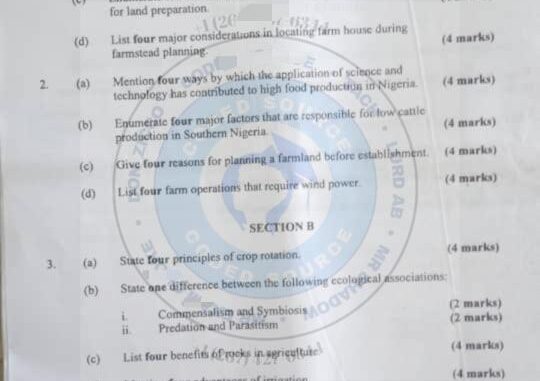
========================================
NECO 2023 AGRICULTURAL SCIENCE QUESTION;-ExamgrandComNg !!!!!




=======================================
2023 NECO AGRIC OBJ;-ExamgrandComNg
1-10: BCDACDABBE
11-20: AABCCBBACD
21-30: CAEECCCAAD
31-40: AEEACBAAAD
41-50: EDEECCAEEE
51-60: BDCACDCCAA
Completed!!!
=======================================
NECO 2023 AGRICULTURAL SCIENCE ANSWERS;-ExamgrandComNg !!!!!
SECTION A:
NECO AGRICULTURAL SCIENCE ANSWERS
SECTION A
=====================================
(1a)
(PICK ANY FOUR)
(i) Environmental Protection: Land use legislation aims to preserve and protect the environment by regulating activities such as deforestation pollution and land degradation.
(ii) Sustainable and Planned Development: The government enforces land use legislation to ensure that development occurs in a strategic and organized manner promoting sustainable growth and preventing haphazard urbanization.
(iii) Public Health and Safety: Legislation helps in preventing the establishment of hazardous industries near residential areas ensuring public health and safety.
(iv) Resource Management: Land use legislation helps in managing and conserving natural resources such as water minerals forests and agricultural lands.
(v) Preservation of Cultural and Historical Heritage: Legislation can protect culturally significant areas or historical landmarks from being destroyed or altered.
(vi) Conflict Resolution: Land use legislation can help resolve conflicts arising from competing land use interests ensuring fair allocation and use of land resources.
(1b)
(PICK ANY FOUR)
(i) Education and Training: NGOs provide training and awareness programs to beekeepers equipping them with knowledge and skills to improve beekeeping practices.
(ii) Capacity Building: NGOs offer technical assistance and support to beekeepers helping them enhance their knowledge of beekeeping techniques hive management and honey production.
(iii) Infrastructure Development: NGOs may help develop beekeeping infrastructure such as apiaries honey processing facilities and storage units to improve production and enhance value chain efficiency.
(iv) Market Access: NGOs assist beekeepers in accessing local and international markets for their bee products facilitating trade and boosting income generation.
(v) Policy Advocacy: NGOs advocate for supportive policies and regulations that promote sustainable beekeeping practices and protect bee habitats.
(vi) Research and Development: NGOs contribute to research efforts related to beekeeping bee diseases and honey production technologies providing valuable scientific knowledge to enhance productivity and sustainability.
(1c)
(PICK ANY FOUR)
(i) Root Extraction
(ii) Lesser Soil Disturbance
(iii) Cost and Efficiency
(iv) Selective Clearing
(v) Environmental Impact
(vi) Reusability
(1d)
(PICK ANY FOUR)
(i) Accessibility
(ii) Topography
(iii) Soil Fertility
(iv) Security
(v) Livestock Management
(vi) Future Expansion
=======================================
(2a)
(PICK ANY FOUR)
(i) By Improving crop varieties
(ii) Mechanization
(iii) Precision agriculture
(iv) Irrigation systems
(v) Pest and disease management
(vi) Post-harvest technologies .
(2b)
(PICK ANY FOUR)
(i) Climate constraints
(ii) Limited grazing land
(iii) Disease prevalence
(iv):Inadequate veterinary services
(v) Limited access to improved breeds
(vi) Socio-cultural factors
(2c)
(PICK ANY FOUR)
(i) Planning helps in selecting suitable land for farming based on factors such as soil type topography drainage and accessibility. This ensures that the farmland is suited for the specific type of crops or livestock to be raised.
(ii) Planning helps maximize land-use efficiency by determining the layout and design of fields pastures or livestock housing structures. It ensures proper zoning and allocation of different areas for various farming activities to optimize space and resources.
(iii) Planning allows for proper soil preparation techniques including soil testing soil amendment and land leveling. These steps help create an ideal growing environment by addressing soil fertility pH levels and water drainage.
(iv) Planning helps identify the need for and placement of essential infrastructure such as irrigation systems fencing drainage channels and access roads. This ensures efficient operations and easy movement of machinery livestock and personnel.
(v) Planning enables the efficient utilization of resources such as water fertilizers and energy. It helps in determining the right amount and timing of resource application reducing wastage and increasing productivity.
(vi) Planning takes into account environmental factors and focuses on sustainable farming practices. It can include measures to prevent soil erosion conserve water minimize chemical use and promote biodiversity. This contributes to long-term farm viability and protects the ecosystem.
(2d)
(PICK ANY FOUR)
(i) Wind-powered water pumping
(ii) Wind-driven aerators
(iii) Wind energy for electricity generation
(iv) Wind-powered grain drying
(v) Windbreak structures
(vi) Wind energy for livestock operations
=======================================
SECTION B
(3a)
(PICK ANY FOUR)
(i) Diversity: Rotate crops with different families or characteristics to prevent the buildup of pests and diseases specific to certain plants.
(ii) Nutrient Cycling: Different crops have different nutrient requirements and nutrient uptake patterns. Rotating crops helps in balancing and replenishing soil nutrients.
(iii) Pest and Disease Management: Crop rotation interrupts pest and disease life cycles reducing their buildup and decreasing reliance on chemical controls.
(iv) Weed Control: Alternating crops with different weed control strategies helps in managing weed populations and reducing herbicide use.
(v) Soil Health Improvement: Crop rotation diversifies the root system improving soil structure organic matter content and overall soil fertility.
(vi) Economic Sustainability: Crop rotation helps in spreading out risks and optimizing the use of resources leading to more sustainable and profitable agricultural practices.
(3bi)
-Commensalism and Symbiosis-
(i) Commensalism: This is an association where one organism benefits while the other is neither harmed nor benefited.
(ii) Symbiosis: Symbiosis refers to a close and long-term association between two different species where both organisms benefit.
(3bii)
-Predation and Parasitism-
(i) Predation: Predation is a relationship in which an organism (predator) kills and consumes another organism (prey) for food.
(ii) Parasitism: Parasitism is a relationship in which one organism (parasite) benefits at the expense of another organism (host) by obtaining nutrients or shelter from the host.
(3c)
(PICK ANY FOUR)
(i) Soil Structure Improvement
(ii) Nutrient Release
(iii) Erosion Control
(iv) Heat Regulation
(v) Microhabitat Creation
(vi) Aesthetics
(3d)
(PICK ANY FOUR)
(i) Irrigation supplies water to crops during dry periods ensuring adequate moisture for optimal growth and higher crop yields.
(ii) Irrigation allows farmers to control the timing and amount of water applied ensuring efficient water use and reducing water stress on plants.
(iii) During droughts or water scarcity irrigation can help maintain crop production by providing supplementary water.
(iv) Irrigation can be used to leach excess salts from the soil preventing soil salinization and enhancing overall soil fertility.
(v) With irrigation farmers have the freedom to cultivate a wider range of crops that may require more water or are not suited to rain-fed conditions.
(vi) Irrigation can enable farmers to grow crops outside their natural growing season extending the production period and increasing profitability.
=====================================
(4a)
Soil pollution refers to the contamination of soil with harmful substances that adversely affect its quality and productivity. It is usually caused by the release of pollutants into the soil through human activities such as industrial operations improper waste disposal and the use of pesticides and fertilizers.
(4ai)
(PICK ANY FOUR)
(i) Implementing proper waste management practices
(ii) Promoting sustainable agriculture
(iii) Installing wastewater treatment systems
(iv) Implementing stricter regulations
(v) Encouraging the use of environmentally friendly products
(vi) Creating awareness and education
(4b)
(i) Sample collection: Collect representative soil samples from the area of interest using appropriate sampling techniques and tools.
(ii) Sample preparation: Clean the soil samples by removing debris stones and other impurities. Air-dry the samples and crush them to a uniform particle size.
(iii) Extraction of nutrients: Extract the plant-available nutrients from the soil using suitable extraction solutions such as a dilute acid or salt solution. This process helps to determine nutrient concentrations in the soil.
(iv) Analysis and interpretation: Analyze the extracts using appropriate laboratory techniques such as spectrophotometry or titration to determine nutrient concentrations. Interpret the results to assess nutrient availability and soil fertility status.
(4ci)
ADVANTAGES
(PICK ANY THREE)
(i) Prevents waterlogging
(ii) Enhances aeration
(iii) Reduces erosion (iv) Improves soil structure
(v) Prevents nutrient leaching
(vi) Minimizes disease incidence
DISADVANTAGES
(PICK ANY THRRE)
(i) Loss of water resources
(ii) Soil erosion
(iii) Cost and maintenance
(iv) Environmental impact
(v) Disruption of natural habitats
(vi) Unintended consequences
=======================================
(5ai)
GIVEN:
D=1960cm
R=D/2=1960/2cm
=>The area of the farmland is A = πr²/4 = π(1960cm/2)²/4 = 3,018,306.92 cm²
(5aii) The number of mounds on the farmland is N = A/2m² = 1,509,153.46 mounds
(5aiii) The total number of setts needed is S = N * 5000 sett/ha = (N * 5000 sett/ha) * (10,000 m²/ha) = 75,457,673,000 setts
(5aiv)
(I) intercropping with legumes or vegetables to improve soil fertility and reduce weed growth
(II)crop rotation with other crops like maize or cassava to reduce pest and disease pressure
(III)mulching to conserve soil moisture and suppress weed growth.
(5b)
(i)Selecting appropriate tree species that are compatible with other crops in the system and can provide multiple benefits such as shade, soil improvement, and biodiversity conservation.
(ii) Planting trees at the appropriate density and spacing to avoid competition with other crops for resources such as water and nutrients.
(iii). Pruning and managing trees regularly to maintain a balance between their growth and the needs of other crops in the system.
(5c)
(i) Impatiens spp. (touch-me-nots)
(ii) Cardamine hirsuta (hairy bittercress)
(iii) Oxalis spp. (wood sorrels)
=======================================
(6ai)
It helps to reduce soil temperature, conserve soil moisture and prevent rotten of yam setts.
(6aii)
It ensures adequate exposure of the leaf surface to sunlight and increases yield.
(6aiii)
To ensure even spreading and neatness of the vines to receive sunlight.
(6bi)
Pennisetum purpureum.
(6bii)
Axonopus compressus.
(6biii)
Stylosanthes gracilis.
(6biv)
Pueraria phaseoloides.
(6c)
(i) Weeds help in checking soil erosion.
(ii) Some weeds ate useful as food for humans.
(iii) Some weeds serve as feed for livestock.
(iv) Certain weeds have medicinal properties.
(6d)

=======================================
SECOND D
(7a)
(PICK ANY FOUR)
(i) Genetic qualities: Look for rabbits with good genetic traits such as high fertility high growth rates and disease resistance. Breeding animals with desirable traits will help improve the overall quality of the offspring.
(ii) Health and fitness: Select rabbits that are healthy free from any genetic disorders and have good overall physical condition. This ensures that the offspring will have a better chance of being healthy and thriving.
(iii) Temperament: Choose rabbits with a calm and friendly temperament. This will make handling and management easier as well as contribute to better overall welfare.
(iv) Productivity: Consider the productivity of the rabbits such as their ability to reproduce and raise litters successfully. Look for rabbits with a history of good mothering skills and high milk production.
(v) Conformation: Evaluate rabbits for proper conformation including body shape posture and proportions. Rabbits with good conformation are more likely to have better reproductive success and overall health.
(vi) Diversity: Avoid inbreeding by selecting breeding rabbits from different bloodlines. This helps maintain genetic diversity which can contribute to stronger and healthier offspring.
(7b)
(PICK ANY FOUR)
(i) Temperature control
(ii) Humidity control
(iii) Egg turning
(iv) Ventilation
(v) Egg monitoring
(vi) Egg handling
(7c)
(i) Temperature
(ii) Diet
(iii) Physiological state
(iv) Activity level
(7d)
(i) Amylase
(ii) Proteases
(iii) Lipase
(iv) Nucleases
===============================================
(8a)
(i) Blood carries nutrients and oxygen from the digestive system and lungs to various tissues and organs of the body ensuring proper nutrition and oxygenation.
(ii) Blood carries metabolic waste products such as carbon dioxide and urea to organs like the lungs and kidneys for elimination from the body.
(iii) Blood contains white blood cells that help in fighting against diseases and infections by identifying and destroying pathogens.
(iv) Blood plays a role in maintaining the body’s temperature through heat distribution throughout the body and heat exchange with the environment.
(8bi)
-Hides-
(PICK ANY TWO)
(i) Hides are used to produce high-quality leather which is used in the manufacturing of shoes belts bags and various other leather products.
(ii) Hides can be used in meat processing such as in the production of gelatin and edible collagen.
(iii) Hides of certain animals like fur-bearing animals are used in the production of fur garments and accessories.
(iv) Hides can be exported and traded internationally contributing to the economy.
(8bii)
-Eggs-
(PICK ANY TWO)
(i) Eggs are a significant source of protein and other essential nutrients making them a valuable part of human diet.
(ii) Eggs are used in various food products such as baking confectionery and pasta production.
(iii) Eggs can be exported and traded locally and internationally providing opportunities for economic growth.
(vi) Eggshells can be used in various applications such as for calcium supplements fertilizer production and even in waste treatment processes.
(8biii)
-Tail-
(PICK ANY TWO)
(i) Tails of certain animals like cows and pigs are used in recipes to add flavor and richness to dishes such as in soups and stews.
(ii) Animal tails can be used in the production of pet food or treats providing a source of nutrition for animals.
(iii) Traditional Medicine: Tails of certain animals have been used in traditional medicine for their perceived health benefits.
(iv) Tails can be used in the manufacturing of products like brushes ornaments and even fashion accessories.
(8ci)
IODINE
-One function-
(i) Iodine is essential for the synthesis of thyroid hormones which are responsible for regulating the body’s metabolism and growth.
-One deficiency symptom-
(i) Iodine deficiency can lead to the development of a condition called goiter where the thyroid gland becomes enlarged. Other symptoms may include hypothyroidism impaired mental development and decreased fertility.
(8cii)
MAGNESIUM
-One function-
(i) Magnesium plays a crucial role in various physiological processes such as muscle and nerve function DNA synthesis energy production and maintaining normal heart rhythm.
-One deficiency symptom-
(i) Magnesium deficiency can lead to symptoms such as muscle cramps tremors weakness fatigue abnormal heart rhythms and calcium and potassium imbalances.
(8ciii)
CALCIUM
-One function-
(i) Calcium is vital for the development and maintenance of strong bones and teeth. It also plays a role in muscle function nerve transmission and enzymatic reactions within the body.
-One deficiency symptom-
(i) Calcium deficiency can result in weakened bones and teeth leading to conditions like osteoporosis and dental problems.
=======================================
(10a)
Scale of preference is defined as a list of unsatisfied wants arranged in the order of their relative importance. OR It is a list showing the order in which we want to satisfy our wants arranged in order of priority. (CHOOSE ANY ONE YOU LOVE FROM THE BOTTOM OF YOUR SOUL).
(10bi – 10biii)
CHECK THE COMING SOON DIAGRAM…
(10biv)
(i) Sales Account.
(ii) Purchase Account.
(10c)
(i) It enables participants to debate issues and make sound judgments about lessons being taught.
(ii) It appeals to logic and reasoning.
(iii) It provides a problem-solving practical experience. That is, it makes learning easier.
(iv) It allows the teaching of a larger number of farmers at the same time.
(v) It is more economical in terms of time, energy and other resources compared to other methods.
(vi) Communication is made much easier for the extension officer and agent.
=======================================





Be the first to comment